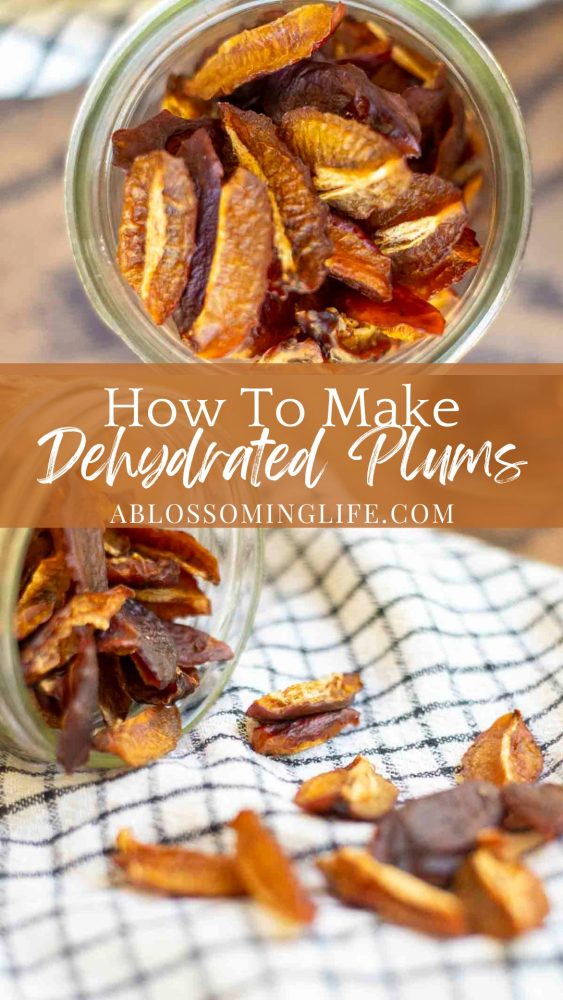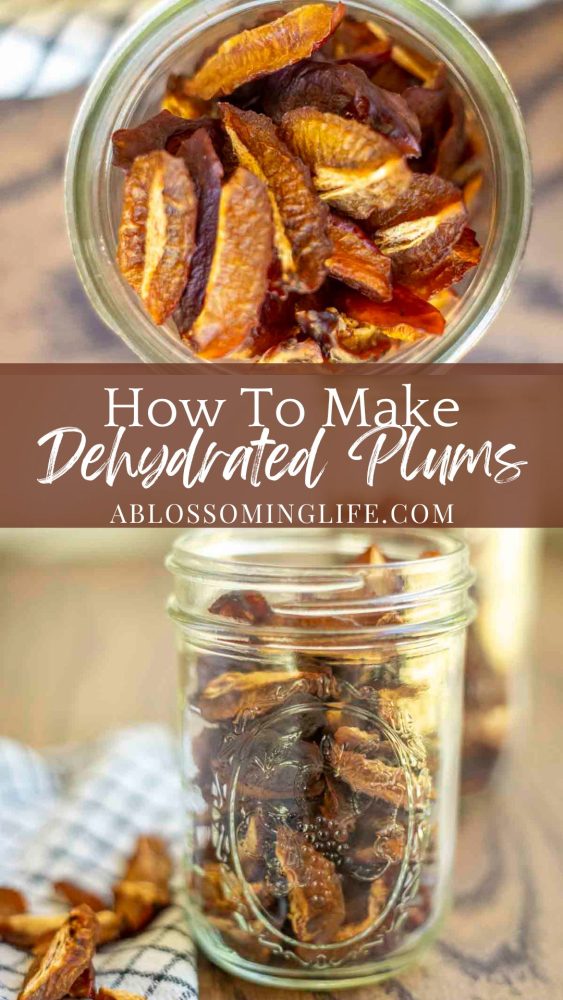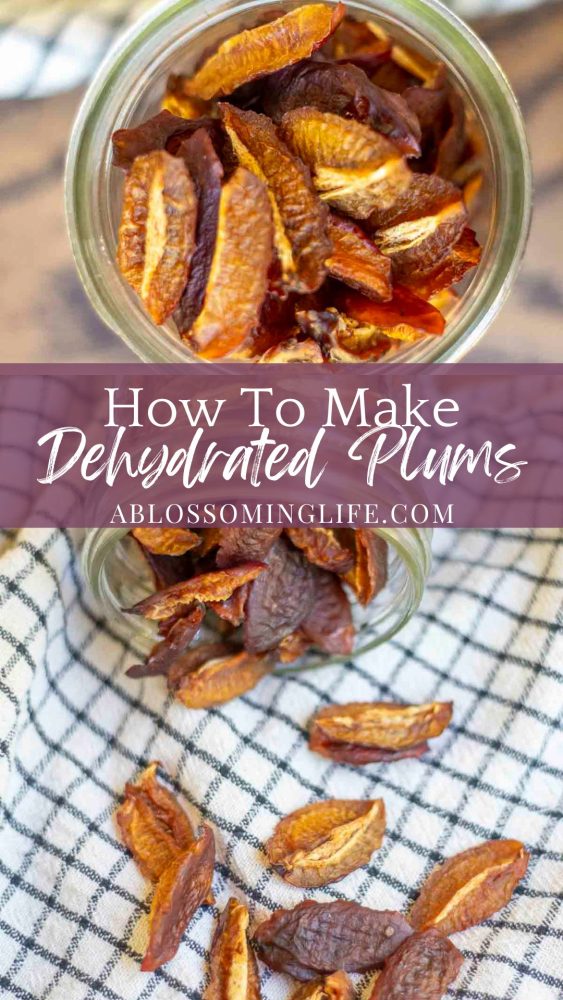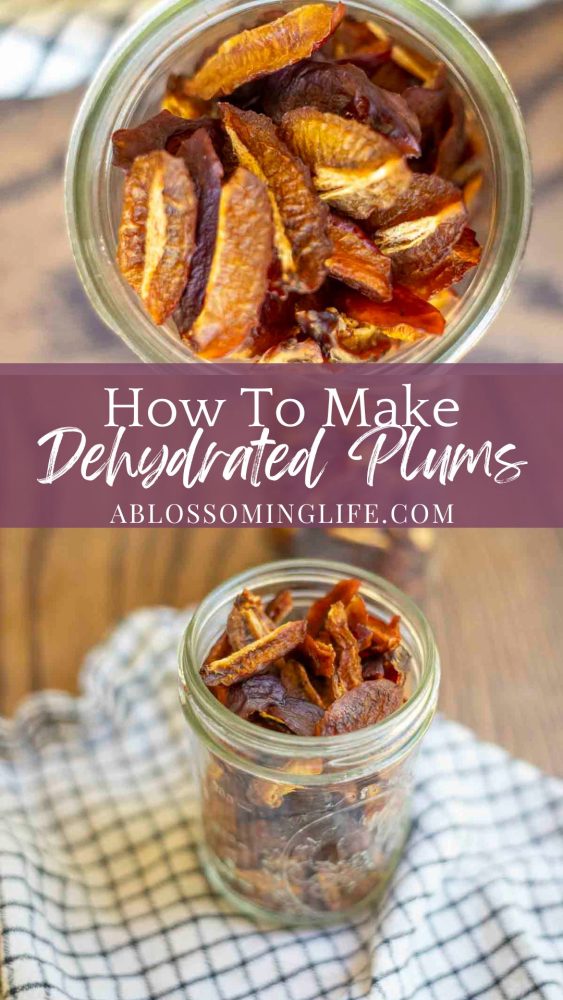How To Dry Plums
This post may contain affiliate links. Read disclosure policy.
Learn how to dry plums to make a delicious and shelf stable snack. Dehydrated plums are a healthy, sweet, and slightly sour snack- completely different from the store-bought versions.

Why you will love dried plums:
Delicious: Dried plums, also known as prunes, are a versatile and delicious ingredient that can enhance your culinary adventures in countless ways. Whether you’re a fan of their natural sweetness or prefer to use them in savory dishes, dried plums offer a unique flavor profile that is sure to impress your taste buds.
Convenient: Unlike fresh plums, which have a short shelf life and can easily go to waste if not used promptly, dried plums can be stored for months, even years, without losing their taste or nutritional value. This means that you can enjoy the fruity goodness of plums any time of the year, even when they are out of season.
Versatile: These little gems can be used in a wide range of recipes, from desserts and snacks to main courses and salads. You can add them to your morning oatmeal for a burst of natural sweetness, incorporate them into your homemade granola bars for an extra dose of flavor, or even use them as a topping for a hearty winter stew. The possibilities are endless!
Healthy snack full of health benefits: They are a great source of dietary fiber, which aids in digestion and helps keep you feeling full for longer. Dried plums are also packed with antioxidants, vitamins, and minerals, making them a nutritious addition to your diet.
Great way to preserve the harvest: Reduce food waste and your grocery bill by learning to dry fruit.
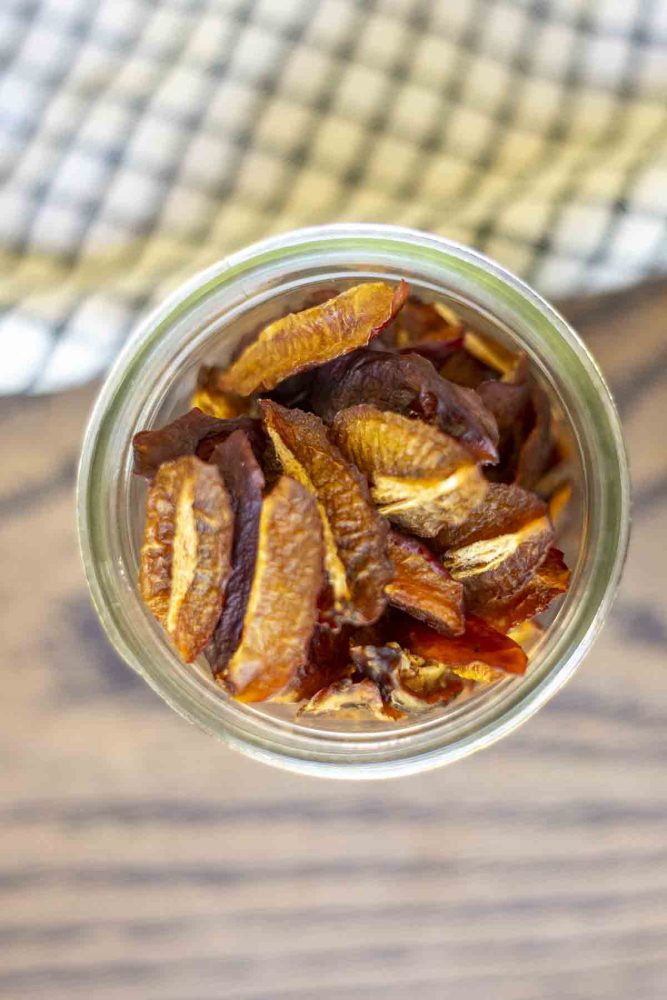
Tips For Dehydrating Plums
- Choose plums that are ripe but still firm. This will ensure that they dehydrate evenly and retain their flavor and texture.
- Before you start the dehydration process, make sure to wash the plums thoroughly and remove any stems or leaves.
- The drying time for plums can vary depending on factors such as humidity and the thickness of the slices. Generally, it can take anywhere from 8 to 24 hours for plums to become fully dehydrated. To test if they are done, remove a slice from the dehydrator and let it cool for a few minutes. It should be leathery and slightly pliable, with no moisture remaining.
- Once the plum slices are fully dehydrated, allow them to cool completely before storing them in an airtight container.
Tools you may need:
Food Dehydrator: Investing in a dehydrator is highly recommended for dehydrating plums efficiently. Look for a model with adjustable temperature settings, as this will allow you to customize the drying process based on the thickness of the slices and desired texture.
Knife
Cutting Board: A sturdy cutting board will provide a stable surface for slicing the plums. Opt for a material that is easy to clean and won’t absorb moisture or odors from the fruit.
Parchment Paper or Dehydrator Sheets: Placing parchment paper or dehydrator sheets on the trays of your dehydrator will prevent the plum slices from sticking to the surface. This makes it easier to remove the dehydrated plums once they are fully dried.
Airtight Containers: Mason jars or food-grade plastic containers with tight-fitting lids work well for preserving the dried plums.

How To Dry Plums:
Rinse the plums under cool water to remove any dirt or debris.
Slice the plums in half, and carefully remove the pits from each plum using a sharp knife or a pitter. This step is essential as the pits can affect the texture and taste of the dried plums.
Depending on the size of your plums, you can keep them in halves or slice into pieces about ¼ to ½ inch thick for optimal drying. This consistency will allow for even dehydration and prevent any overly chewy or under-dried pieces.
Once the plum slices are ready, you can choose to pre-treat them to prevent browning. While it’s not necessary, pre-treating will help maintain the vibrant color of the plums.
You can achieve this by dipping the slices in a solution of lemon juice and water. I usually skip this step. Because of their deep purple color, you don’t really see the browning anyhow.
Arrange the slices in a single layer on the dehydrator trays or a baking sheet lined with parchment paper. Make sure to leave some space between the slices to allow for proper air circulation.
If using a dehydrator, set the temperature to around 135°F to 140°F (57°C to 60°C) and let the plums dry for approximately 8 to 24 hours.
While the exact drying time will depend on various factors such as the thickness of the slices and atmospheric conditions, you’ll know the plums are fully dehydrated when they are pliable with no visible moisture. They should feel slightly sticky to the touch but not moist.
To test their readiness, simply take a slice and let it cool for a few minutes. If it feels dry and leathery, your plums are ready for storage.
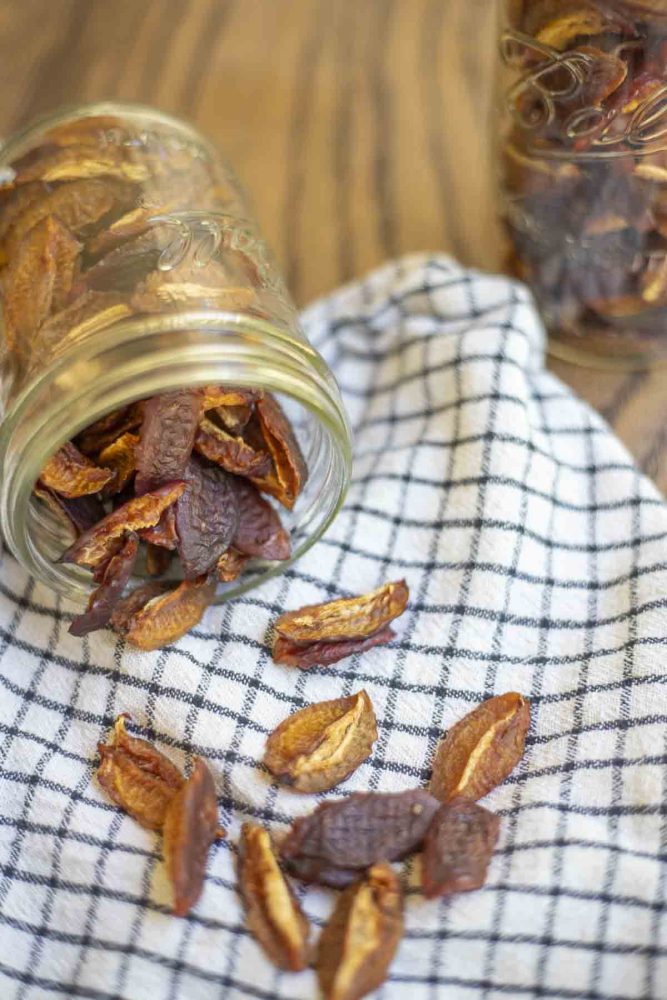
How To Dry Plums In The Oven:
Wash and dry plums.
Slice into halves or 1/4 to 1/2 sized pieces. This will be dependent on the size of your plums.
Place sliced plums on baking sheets lined with parchment paper or silicon baking mats. This prevents sticking.
Set the oven to the lowest temperature possible (this is usually around 150-200 degrees) and keep an eye on the plums as they dry.
Save This Recipe
Place trays in the oven.
Rotate the trays occasionally to ensure even drying evenly.
Cook until completely dried through. This can take anywhere from 3 to 8 hours.
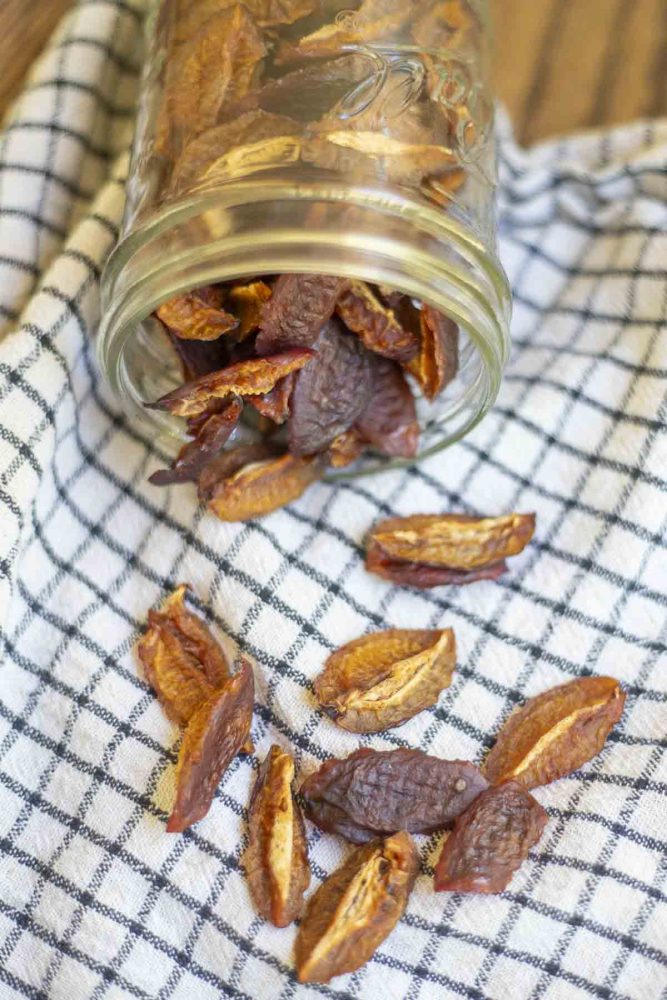
Storage:
Store in airtight containers are key to preserving the flavor and texture of the dried plums.
Mason jars or food-grade plastic containers with tight-fitting lids, or mylar bags will do the trick.
Transfer the cooled plum slices into the containers and seal them tightly. By doing so, you’ll create a barrier that protects the plums from air and moisture, ensuring their deliciousness remains intact for an extended period.
Add an oxygen absorber for longer storage.
Place in a dark, cool place for up to a year.
However, it’s important to keep an eye on any signs of spoilage, such as mold or off odors. If you notice any of these signs, it’s best to discard the affected plums to prevent the problem from spreading to the rest of your dried fruit supply.
Keep them away from areas with high humidity, such as the kitchen countertop near the sink or refrigerator. Moisture can compromise the quality of your dried plums and lead to spoilage, so it’s best to store them in a dry environment to ensure their longevity.
FAQ
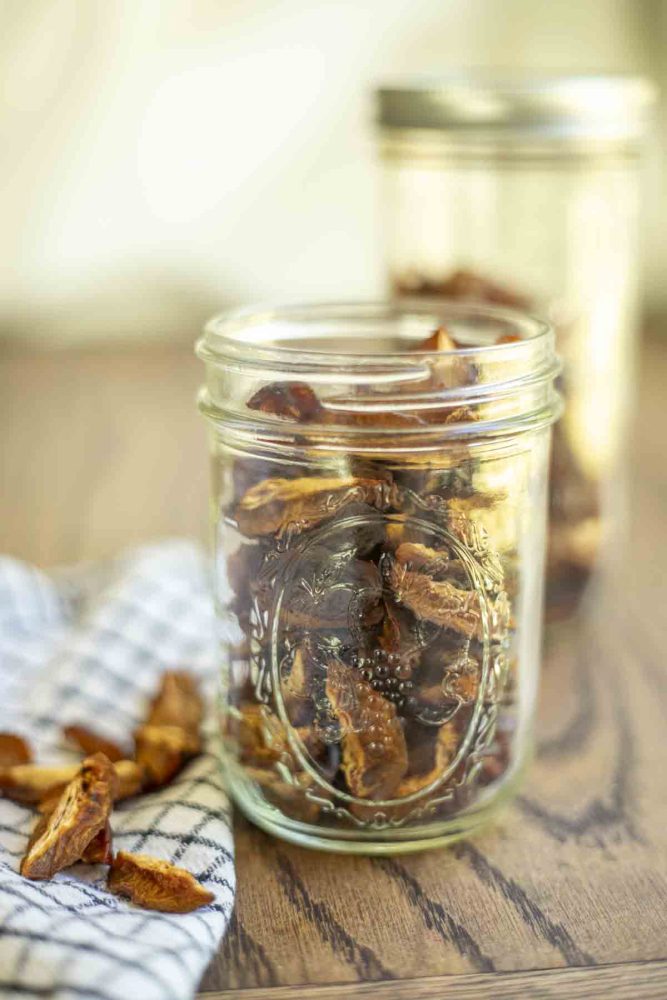
Why are my dehydrated plums still sticky?
If your dehydrated plums are sticky, it could be an indication that they were not dried thoroughly. To ensure proper dehydration, make sure to slice your plums uniformly and follow the recommended drying time and temperature.
Additionally, check for any signs of moisture or stickiness before storing them. If your plums are still sticky, you can return them to the dehydrator for a little longer until they are fully dry.
Can I use dehydrated plums in savory dishes?
Absolutely! Dehydrated plums can add a unique flavor and texture to a variety of savory dishes. You can incorporate them into salads, grain bowls, or even use them as a sweet and tangy addition to meat dishes like roasted chicken or pork.
Experiment with different combinations to discover your favorite flavor profiles.
How long can I store dehydrated plums?
When properly dehydrated and stored in airtight containers in a dry environment, dehydrated plums can be stored for up to a year. However, it’s essential to regularly check their condition and discard any that show signs of spoilage or deterioration.
Remember to label your containers with the date of drying to keep track of their freshness.
What should I do if my dehydrated plums become moldy?
Mold is a common concern when it comes to storing dehydrated fruits. If you spot any signs of mold on your plums, it’s best to discard them immediately. Mold can spread quickly and compromise the quality of the entire batch.
To prevent mold growth, make sure your plums are thoroughly dried before storing them, and keep them away from areas with high humidity.
Can I rehydrate dehydrated plums?
Yes, you can rehydrate dehydrated plums by soaking them in warm water for about 30 minutes to an hour. The amount of water needed will depend on your desired texture and the plums’ initial dryness. Once rehydrated, you can use them in various recipes or enjoy them as a juicy snack.
Are dried plums good for you?
Yes. They are full of fiber, vitamins, and minerals. They are a great healthy snack.
Find More Ways To Preserve The Harvest:
- How To Dehydrate Blueberries
- How to Freeze Kale – 2 Easy Ways
- Dehydrated Strawberries
- Preserving Tomatoes Without Canning
- How To Freeze Blueberries- The Easiest Way Ever
- How to Freeze Zucchini
If you try this recipe and love it, I would love if you could come back, comment on the post, and give it 5 stars! Please and thank you.
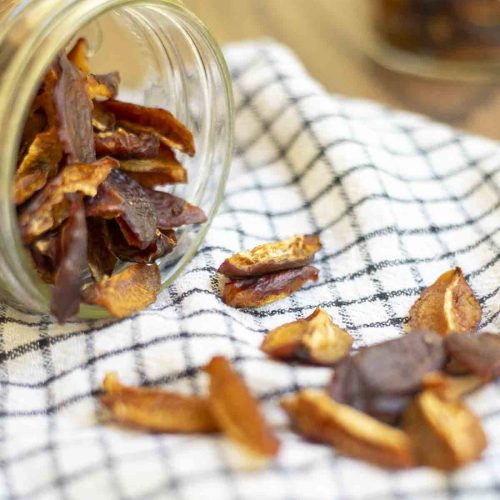
Save This Recipe
Equipment
Ingredients
- 1-5 pounds plums this depends on the size of the dehydrator or your baking sheets
Instructions
- Rinse the plums under cool water to remove any dirt or debris.
- Slice the plums in half, and carefully remove the pits from each plum using a sharp knife or a pitter.
- Depending on the size of your plums, you can keep them in halves or slice into pieces about ¼ to ½ inch thick for optimal drying.
- Once the plum slices are ready, you can choose to pre-treat them to prevent browning by dipping in lemon juice. While it’s not necessary, pre-treating will help maintain the vibrant color of the plums. I usually skip this step.
- Arrange the slices in a single layer on the dehydrator trays or a baking sheet lined with parchment paper. Make sure to leave some space between the slices to allow for proper air circulation.
- If using a dehydrator, set the temperature to around 135°F to 140°F (57°C to 60°C) and let the plums dry for approximately 8 to 24 hours.
- You’ll know the plums are fully dehydrated when they are pliable with no visible moisture. They may feel slightly sticky to the touch, but not moist.
- To test their readiness, simply take a slice and let it cool for a few minutes. If it feels dry and leathery, your plums are ready for storage.
Notes
- Choose plums that are ripe but still firm. This will ensure that they dehydrate evenly and retain their flavor and texture.
- Before you start the dehydration process, make sure to wash the plums thoroughly and remove any stems or leaves.
- The drying time for plums can vary depending on factors such as humidity and the thickness of the slices. Generally, it can take anywhere from 8 to 24 hours for plums to become fully dehydrated.
- To test if they are done, remove a slice from the dehydrator and let it cool for a few minutes. It should be leathery and slightly pliable, with no moisture remaining.
- Once the plum slices are fully dehydrated, allow them to cool completely before storing them in an airtight container.


